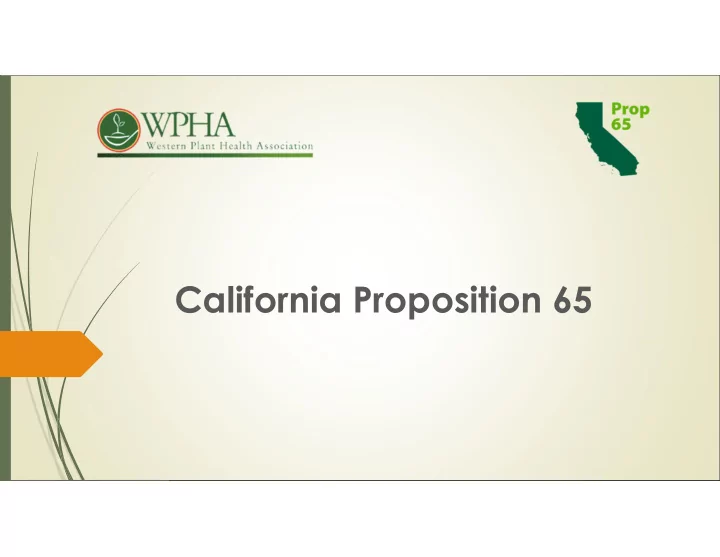

California Proposition 65
California State Proposition 65 , the Safe Drinking Water and Toxic Enforcement Act of 1986, was enacted as a “right to know” ballot initiative in November 1986. Listing Processes Warning Requirements Enforcement
Proposition 65 - Fundamentals List of Chemicals "known to the state" to cause Cancer Reproductive toxicity (includes developmental toxicity) Warning requirements for persons exposed Clear And Reasonable Warning required when exposure levels are significant Discharge into sources of drinking water prohibited When exposures are significant Enforcement Through Litigation Burden on Defendant
Small Businesses with less than State agencies 10 employees Exempt Federal agencies
Areas of Science: Three Areas of Science: Listing and the Delisting " Safe Harbor " Levels No Significant Risk Levels (NSRL) Maximum Acceptable Dose Levels (MADL) Exposure Assessments Safe Use Determinations (SUD)
Authoritative Bodies Mechanism Recognized Authorities – Recognized Authorities – DART Cancer US EPA US EPA US FDA US FDA NIOSH – National Institute NIOSH for Occupational Safety and Health IARC (Trans-placental IARC – International carcinogenicity) Agency for Research on Cancer NTP (Center for Evaluation of Risks to Human Reproduction) NTP – National Toxicology Program
Proposition 65 List The present list contains approximately 1,000 chemicals, metabolites and substances. Pesticides listed - 140: 42 no longer in marketplace 35 have less than 10 lbs active ingredient (a.i.) used Top 8 make up 93% of lbs a.i. of Prop 65 pesticide use Top 20 product a.i.s account for 592 product labels
California Active Registrations – Number of Labels 250 200 150 100 50 0
New Warning Regulation Beginning August 30, 2018, labels are required to contain a pictogram for toxic hazards followed by the word WARNING in bold, capital letters. The new labels also require all products, including food, to list the specific chemicals in the text of the warning and say that the product “can expose you” to the carcinogen or reproductive toxin. Finalized in August 30, 2016 Required on August 30, 2018 OEHHA Website Guidance for Businesses Side-By-Side Comparison to Old Regulations Regulations: Definitions Responsibility for who provides Warning detailed Details by Sector
New Warnings Added: WARNING Added name of actual chemical(s) Examples: ethylene glycol Changed From: “This product contains a chemical known to the state ---" To: “This product can expose you to chemicals including ethylene glycol, which is known to the state of California to cause developmental toxicity." Added: "For more information go to www.P65Warnings.ca.gov."
Prop 65 Regulation allows businesses to request new tailored 11 warning. ATTENTION This product can expose you to chemicals including (listed pesticide active ingredient) which is known to the state of California to cause cancer. For more information, go to www.P65Warnings.ca.gov. Notwithstanding subsection (a)(2) or (b)(2), where a warning for a consumer product exposure or occupational exposure from use of a pesticide is provided on a product label, and the pesticide label is regulated by the United States Environmental Protection Agency under the Federal Insecticide, Fungicide, and Rodenticide Act, Title 40 Code of Federal Regulations, Part 156; and by the California Department of Pesticide Regulation under Food and Agricultural Code section 14005, and Cal. Code of Regs., title 3, section 6242; the word “ATTENTION” or “NOTICE” in capital letters and bold type may be substituted for the word “WARNING”.
What are the warning responsibilities for manufacturers and retailers? The new system clarifies that manufacturers have the primary responsibility for providing proposition 65 warnings. Manufacturers can choose whether to put warning labels on their products or to provide notices to their distributors, importers or retail outlets that have a product that may cause an exposure to a listed chemical. Commercial vs Consumer goods warnings Manufacturers can also enter written agreements with retailers to modify this allocation of responsibility as long as the consumer receives a clear and reasonable warning for which he or she is exposed to a proposition 65 chemical Retailers must confirm that they received the notice and must use the warning signs or other materials provided by the manufacturer. If a product label also contains information in a second language, the product must also contain a Prop. 65 warning in that language.
Summary: Timing: August 30, 2018 – New warnings mechanisms in place; prohibition of discharges still in place. Inerts on a confidential statement of formula (CSF) may also require a product to warn… based on their NSRL or MADL. Each registrant, manufacturer, and business must decide upon their “warning” strategy which may be different for different products in the company’s portfolio. Future – More pesticides/inerts to be listed. Ultimately – Prop 65 is litigation driven$.
Thank You! For complete Prop 65 listings and information go to: www.P65Warnings.ca.gov.
Recommend
More recommend